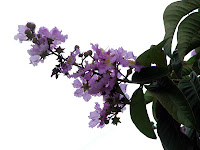
Lagerstroemia microcarpa


Lagerstroemia

Woodfordia
FAMILY OF THE WEEK : LYTHRACEAE
In India 13 genera and 50 species occur throughout tropical India.
The common examples are pomegranate, Henna and crape myrtle.
Vegetative characters:
Herbs shrubs or trees.
The important anatomical feature is the presence of bicollateral vascular bundles in the stem.
The leaves are usually opposite or sometimes whorled, simple and entire.
The stipules are absent or very small.
Inflorescence and flowers:
The flowers are terminal and solitary or cymose or axillary solitary or in small trichotomous cymes or in racemes or in panicles.
The flowers are actinomorphic or sometimes zygomorphic as in Cuphea, hermaphrodite, usually four-,six-,or eight-merous and peri or epigynous.
Usually a hypanthium is present from which sepals petals and stamens appear to arise.
The sepals are four six or eight springing from the margin of the hypanthium. The aestivation is valvate.
The hypanthium is frequently subtended by an epicalyx of connate bracts. The petals are as many as the sepals. The stamens are usually twice as many as the petals and are inserted below the petals. In Punica and Lagerstroemia they are numerous and are in many whorls. The gynoecium is two to six carpellary and syncarpous.
Fruits and seeds:
The fruit is usually a capsule dehiscing transversely or by valves or irregularly. In Punica it is a berry with a thick and leathery pericarp. The seeds are non endospermic and with a straight embryo. In Punica the outer seed coat becomes pulpy and it contains juice.
Pollination and seed dispersal:
The flowers are pollinated by bees which visit them for nectar which is collected in lower part of the hypanthium tube. The seeds are dispersed by wind water or by birds and animals.
Examples:
Lagerstroemia flos –reginae (syn) L. speciosa. (Queen crape myrtle)Tamhan
Lagerstroemia indica(Crape myrtle)
Lagerstroemia parviflora
Lagerstroemia lanceolata
Lawsonia inermis(syn)L.alba (Henna, Mehendi)
Punica granatum(Pomegranate)
Woodfordia fruticosa(Dhayti)













